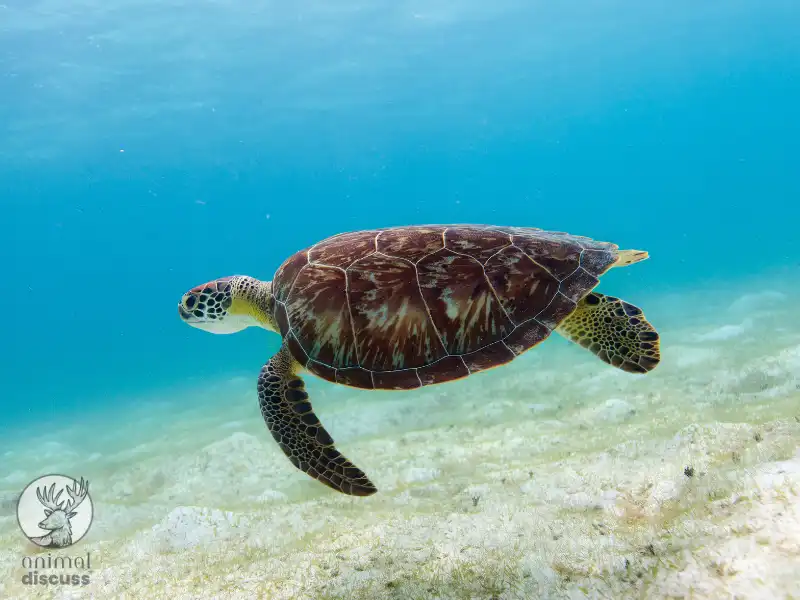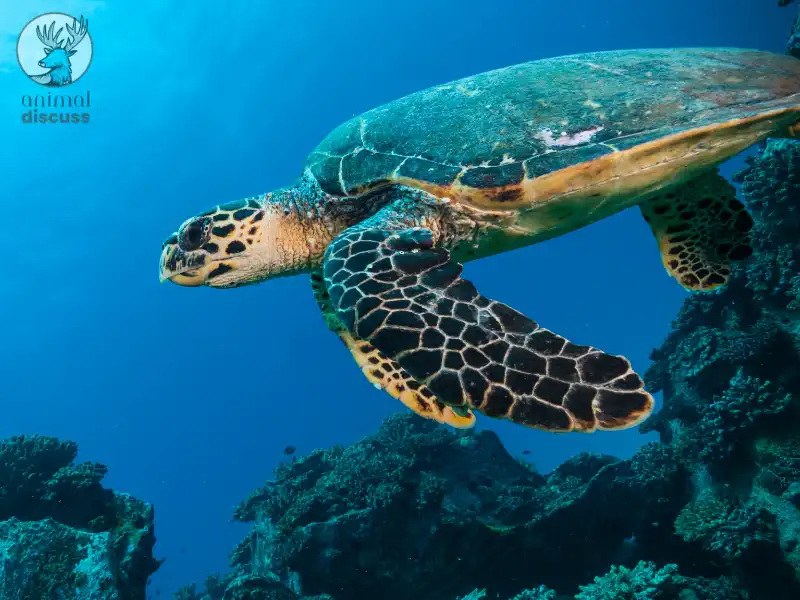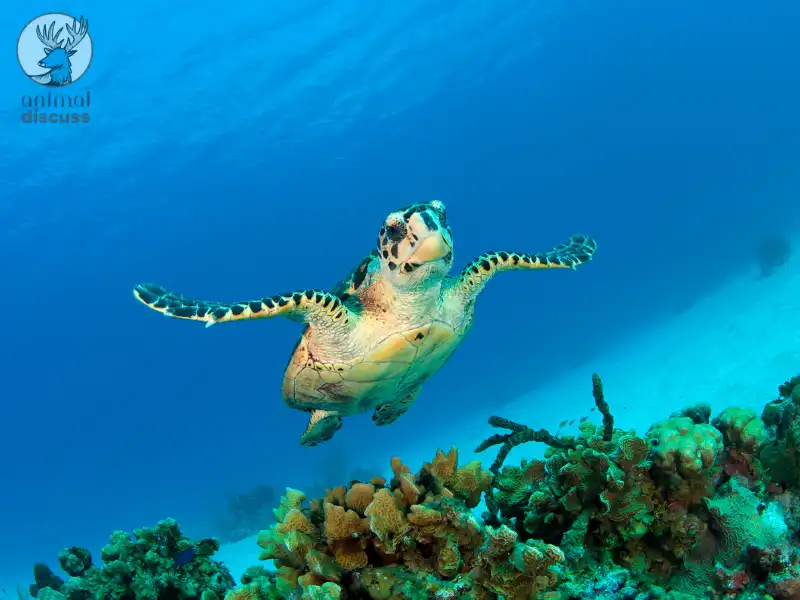Spotted the dazzling hawksbill in the sea yet? To know about these sea jewels, you should dive into their enthralling world and lifestyle.
The beak of the hawksbill sea turtle is its most distinctive feature. Hawksbill sea turtles mainly have overlapped scutes, or big scales, on their carapace, or upper shell, in contrast to other species of sea turtles. Some regions have been collecting hawksbill turtles for decades in order to remove their exquisite scutes.
Their shells can be utilized as fashion jewelry, combs, barrettes along with other souvenirs. Want to know more about them? Explore the whole article to fulfill your interest!
What Are the General Characteristics of Hawksbill Turtles? (Reference 1) (Reference 2)
I have added a brief description to help you explore the world of hawksbill sea turtles with this handy table. This table is packed with key facts about their habitat, behavior, and more. Take a look!
| Aspects | Description |
|---|---|
| Scientific Name | Eretmochelys imbricata |
| Family | Cheloniidae |
| Habitat | Adults prefer coral reefs, coastal areas, and tropical oceans; Juveniles occur in nearshore waters of the Gulf of Mexico and local waters within Aransas, Packery, and Mansfield Channel jetties |
| Diet | Primarily sponges, but also jellyfish, algae, mollusks, and crustaceans |
| Size | Adults range from 2 to 3 feet (60 to 90 cm) in length |
| Weight | 100 to 150 pounds (45 to 68 kg) |
| Lifespan | Estimated to be around 30 to 50 years in the wild |
| Shell | Distinctive; Colorful shell with overlapping scales, known as scutes |
| Coloration | Shell color varies; Often displaying shades of brown, green, amber, orange, red, yellow, and black |
| Predators | Eggs and hatchlings are preyed upon by crabs, birds, and other predators; Adults face threats from sharks and humans |
| IUCN Red List | Critically endangered |
| Communication | Limited vocalization; Communication through body language and chemical cues |
Now, let me share some of the most interesting parts about them! Do you know hawksbill sea turtles are known to dive to depths of up to 1500 feet? It means they can go 450 meters deep. This diving prowess helps them to get food as well as allows them to evade predators.

Their face has four scales between their eyes which are arranged in two pairs. Along each side of its shell, it has four states which are like tough scales. These features help distinguish hawksbills from other sea turtle species so easily!
The head of a hawksbill sea turtle comes in a pointy shape, similar to a bird called a hawk. Its lower jaw looks like the letter V, which adds to its hawk-like appearance. This unique head shape helps hawksbills find and munch on their favorite food, sponges, while swimming gracefully through coral reefs.
Hawksbill turtles are like little growth superheroes, but their speed varies depending on their age. Juveniles kick start their growth spurt, growing super-fast during their first few years. It’s like they are in a race against time!
As they get older, though, their growth slows down, kind of like hitting the turtle brakes. So, while they may start off zooming, they eventually settle into a steady pace, taking their time to reach full turtle greatness.
It is predicted that hawksbills mature at the age of between 20 and 35 years. It can be according to a number of conditions, most notably the availability of resources. Their expected life expectancy is between 50 and 60 years, but this is still unknown.
I hope you understand well. Above of the table can help you learn important facts about hawksbill sea turtles easily. Alright, now if you are more interested to know about their behavior and other things in detail, then you should explore the whole article.
What is the Distribution and Habitat of the Hawksbill Sea Turtle?
Hawksbill sea turtles are mostly found in the Indian, Indo-Pacific, and west Atlantic (Caribbean) oceans. The largest breeding populations are in the Solomon Islands, Australia, and the Great Barrier Reef, where thousands of turtles lay eggs annually.
In the Atlantic Ocean, Mexico, Barbados, and Cuba host many nesting sites, while the Caribbean is a hotspot for nesting activity. Hawaii has a notable nesting population, especially on Molokai’s east coast.
In the Eastern Pacific, from Mexico to Peru, around 700 females nest each year. Hawksbill turtles prefer secluded sandy beaches with minimal human disturbance for nesting. Throughout their lives, they inhabit nearshore areas, especially healthy coral reefs.
Now, what are their preferred habitats? After hatching, young turtles seek shelter in floating algae before migrating to coastal feeding grounds like coral reefs, where they mature. Mangrove estuaries in the Eastern Pacific also support their population.
These habitats, including coral reefs and coastal formations, provide essential shelters for resting turtles and contribute to their overall well-being.
For more information about their habitat, you can read “Where Do Hawksbill Sea Turtles Live? Facts & more”.
What do Hawksbill Turtles Eat? (Reference)
The only known reptile and largest vertebrate that consumes sponges is the hawksbill sea turtle. Its diet varies depending on the region, though.
They eat algae, corallimorpharia, urchins, squid, jellyfish, tunicates, soft corals, zoanthids, as well as sponges without spongin fibers in the Caribbean. Moreover, they consume mangrove fruits, seagrasses, and marine algae in Australia’s Northern Territory.
The primary food source for juvenile hawksbills is drift aquatic organisms. However, pregnant females vary their intake.
Hawksbills, though they differ, are important to coral reef ecosystems. More curious about their food menu? Then read along “Discover the Delicious Diet of Hawksbill Sea Turtles” to know more.
How Do the Lifespan and Fertility of Hawksbill Sea Turtles Vary? (Reference)
Well, female hawksbill turtles go back every one to five years to lay their eggs on beaches. It happens in the same general places where they spawned decades before.
Do you know hawksbill sea turtles are like egg-laying champions? Usually, they produce three to five clutches a season, with a standard of 130 to 160 chicks in each nest. It is like they are playing a giant game of egg roulette! Although it varies according to the locale, the nesting season usually lasts from April to November.

On narrow, remote “pocket” beaches with little to no beaches as well as a rugged approach, hawksbills usually nest at night. Usually, they build their nests high up in the undergrowth on the beach. The eggs take about two months to hatch in the warm sand.
Also, these eggs give themselves enough time to cook up some adorable baby turtles ready to take on the big blue world. At last, the baby turtles go to the water.
And, in order to orient themselves seaward, hatchlings move toward the most glorious horizon. Those can move by avoiding the darkest outline of the plants or the outward dune. This is facing the vast ocean panorama on unspoiled beaches.
How Do Hawksbill Sea Turtles Mate and Behave? (Reference)
Do you know hawksbills are primarily monogamous? Because of this reason, these turtles seldom mate again throughout the season. Besides, who to become partners with is a decision made by the female.
Although it has not been demonstrated, it is thought that turtles would mate with the exact same turtle every season. The size which hawksbills reach varies greatly amongst mating populations. It can range from 66 to 95 cm in length of carapace.
Depending on the availability of food, it could take them anywhere from less than ten to about thirty years to achieve that size. Usually, the process of nesting occurs three times in a mating season, separated by fifteen days.
The female conceals the eggs after depositing them in clutches of one hundred to one hundred and forty at a time. It takes the hatchlings a couple of days to delve themselves out. Again, around the age of three to ten, hawksbills can mate.
More curious about their behavior? Then read along “Hawksbill Sea Turtle Behavior” to know more.
What Threats Face the Hawksbill Sea Turtles? (Reference)
Hawksbill sea turtles face many dangers that threaten their survival. These include getting caught in fishing gear, losing their homes due to habitat destruction, and being harmed by pollution.
Getting trapped in fishing gear accidentally can harm or even kill them. This problem is called bycatch, which is a big issue worldwide. They are symbolic in many cultures.

On the other hand, despite being protected, hawksbills are still hunted for their shells, eggs, and meat. Pollution, coastal development, and climate change are destroying the places where hawksbills live and lay their eggs.
Among all these threats, the illegal trade of their shells is popular. Imagine someone trying to turn your home into a fancy decoration! Their beautiful shells are highly sought after for jewelry and souvenirs. It is like someone trying to snatch away your favorite possession!
Accordingly, hawksbill turtles are often hit by boats, especially near ports and busy coastal areas. Trash in the ocean, like plastic and fishing gear, can hurt or kill hawksbill turtles also if they eat it or get stuck in it.
How are Hawksbill Sea Turtles Protected and What’s Their Conservation Status? (Reference)
In addition to being federally designated as a threatened species since 1970, hawksbill sea turtles have been listed as “critically endangered” on an international level.
Both national laws and a number of international agreements and accords protect hawksbill turtles. Hence, Bycatch, or the unintentional capture of hawksbill turtles by commercial and recreational fishermen, is being decreased. And it is occurring through the use of TEDs (Turtle Exclusion Devices), though.
But hey, good news alert! People around the world are stepping up to protect our hawksbill buddies. Thanks to international agreements and cool conservation programs these turtles are getting serious love.
Picture this: teams of dedicated folks hitting the beaches, keeping an eye on nests, and making sure those precious eggs stay safe. Plus, there is a big push to preserve their homes, like coral reefs and sandy shores, so hawksbills have a comfy place to call home.
It is like having a whole squad of turtle superheroes working to keep our oceans thriving!
How Can You Help the Welfare of Hawksbill Turtles?
We all must protect hawksbill sea turtles. Avoid activities that harm their habitats and follow conservation steps.
- Reduce Ocean Waste: Join beach clean-ups and dispose of fishing line properly. Use reusable bags, and bottles, and avoid releasing bubbles into the water.
- Maintain Distance: Respect turtle nests and attend sea turtle watches. Never feed or handle turtles. Be cautious while boating to avoid striking them.
- Protect Habitat: Keep beaches dark and secure at night. Remove beach equipment and avoid driving on nesting beaches. Fill in holes and destroy sandcastles that hinder nesting turtles.
Likewise, by reducing waste, maintaining distance, and protecting nesting habitats, we can help hawksbill sea turtles thrive. Let’s work together to ensure their well-being!
Frequently Asked Questions
Do you have more inquiries? Don’t worry! Just take a look at the FAQs.
01. Is it common or uncommon to spot hatchlings or hawksbill turtles on the beach?
Very uncommon because the majority of people have not yet witnessed a hawksbill turtle setting a nest or watch one boil (hatch). Both are often active during the night. Therefore, feel really fortunate if you come across these sea turtles.
02. How do hawksbill sea turtles survive?
Hawksbill sea turtles don’t require fresh water to survive; they may survive in the sea. They consume enough water from their food and the seawater they metabolize.
Hawksbill turtles have a salt valve to remove extra salt from their bodies, just like several sea creatures and seabirds. The hawks’ eyes receive the gland’s discharge.
03. How Do Hawksbill Turtles Breathe?
Hawksbill sea turtles breathe air like you. It goes to the surface to breathe in oxygen and release carbon dioxide. They can hold their breath for a long time underwater by slowing down their heartbeat.
This helps them search for food and stay safe from predators. Their ability to balance oxygen needs and life in the sea is truly remarkable!
04. How do hawksbill sea turtles sleep?
The majority of their lives are spent in the water, making hawksbill turtles intriguing creatures. The way these sea reptiles sleep is among their most captivating features. Hawksbill turtles maintain their breath for several hours while sleeping underwater, in contrast to most other species.
05. For how long do hawksbill turtles sleep?
When they sleep or relax, hawksbill turtles are able to hold breaths for four to seven hours. How do they accomplish that? As reptiles, these sea turtles breathe air, much like people do. Underwater, they are unable to breathe.
Wrapping Up
Wow, we’ve journeyed through the incredible world of hawksbill sea turtles! From their stunning characteristics to their vital role in coral reef health, these majestic creatures never cease to amaze. We explored their diverse diet, including sponges and algae.
Also, we’ve learned how they dig into their habitats with their sharp beaks. Though they face threats, like plastic pollution, conservation efforts worldwide are underway to protect these gentle giants. Let’s join hands to ensure their survival and continue marveling at their beauty in our oceans!
Keep an eye out for more ways to help these amazing creatures thrive!

